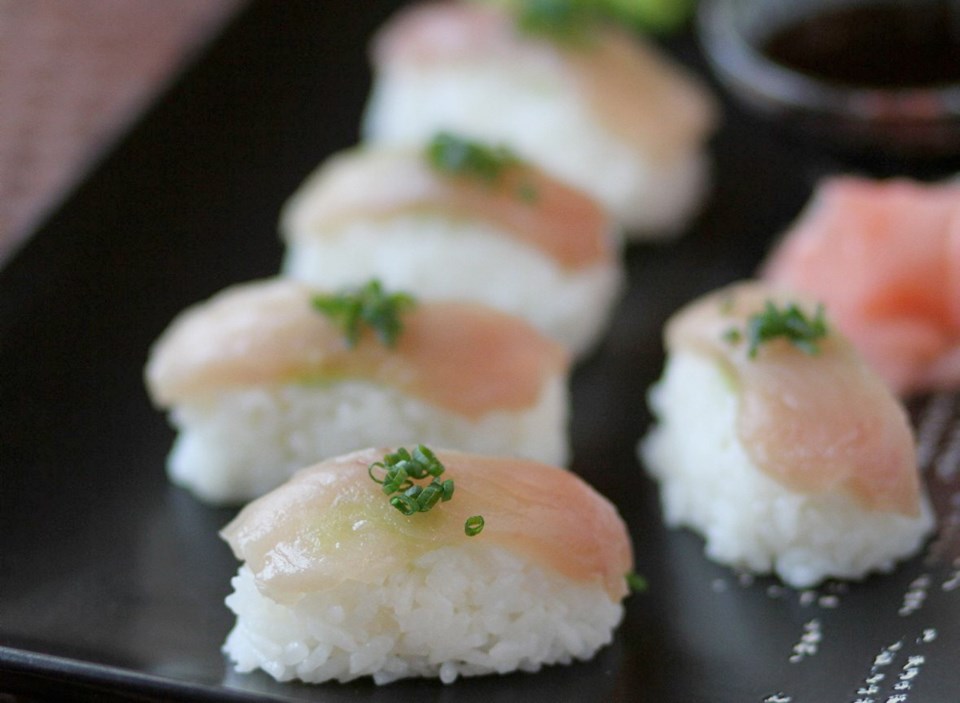 Dear Eric: I would like to make sushi at home, but I’m not sure what sushi-grade fish is. Can you help?
Dear Eric: I would like to make sushi at home, but I’m not sure what sushi-grade fish is. Can you help?
Patricia
Dear Patricia: Sushi grade is a confusing term because, unlike Canada Grade A chicken or Canada AAA beef, there are no government inspectors grading fish to ensure it’s “sushi grade.”
Some provincial health websites, however, do offer a definition of what sushi grade means —or sashimi grade — and why one would want to use it when consuming some types of raw seafood.
According to the Alberta Health Services website, albertahealthservices.ca, the health risks associated with sushi arise from traditional preparation methods for the two main ingredients, raw seafood and acidified sushi rice.
The issue with the rice is more of a concern in a restaurant, where the proprietor must take care not to hold the acidified sushi rice — rice flavoured with vinegar and seasonings — at too high a temperature for so long that it promotes the growth of foodborne bacteria.
At home, this should not be an issue, because home cooks usually use the acidified sushi rice to make sushi soon after it’s made.
The issue with the raw seafood, such as wild salmon, is that it may contain parasites, such as anisakinae (roundworm) and diphyllobothrium (tapeworm), if not handled correctly before it is sliced and used for sushi.
In other words, for it to be “sushi grade” the seller has to confirm the seafood to be served raw has been frozen below -20 C for seven days, or below -35 C for 15 hours, to destroy parasites that might be present.
According to Alberta Heath Services, and other sources, the exception to that rule is
aquaculture-raised fish fed formulated feed that contains no live parasites that can infect the fish, or if the product is confirmed as tuna of the species yellowfin, bluefin or bigeye.
When buying sushi-grade fish, you also want to make sure you do so in a place where the shop selling it is careful about cross-contamination. That means, for example, the sushi-grade fish is not being cut on the same board with the same knife, or being handled with the same gloves, as the non-sushi-grade fish.
When I buy sushi-grade fish, I always purchase it still frozen, in its tightly sealed package. Doing so shows me that the fish has indeed been frozen. It also enables me to cut the fish when still partially frozen, which makes it much easier to cut into nice clean slices.
Patricia, definitely some things to think about here. But if you shop at a reputable place, whether it’s a Japanese food store, standalone seafood store or supermarket seafood counter, where the staff understand what “sushi grade” means, you’ll have confidence the sushi you make is tasty and safe to eat.
B.C. Albacore Tuna Nigiri Sushi
Nigiri sushi is oblong balls of cooked and seasoned sushi rice topped most often with thinly sliced fish or other seafood. In this case, it’s wild B.C. albacore tuna, which is sold frozen at some seafood stores, supermarkets and Japanese food stores. I bought mine at Sakura Restaurant,
1213 Quadra St., which also sells Japanese groceries.
Preparation time: 30 minutes
Cooking time: 15 minutes
Makes: 18 pieces
1 1⁄4 cups sushi rice (see Note)
1 3⁄4 cups cold water
3 Tbsp rice vinegar
1 1⁄2 Tbsp granulated sugar
1 1⁄2 tsp salt
1 (180 to 200 grams) frozen, sushi- or sashimi-grade albacore tuna loin, partially thawed and cut into 18 thin slices
2 green onions, very thinly sliced
• wasabi paste to taste
• soy sauce and pickled ginger
Place the rice in a small pot (mine was 15 centimetres wide and 13 cm tall). Cover with 10 cm of cold water. Use your hands and rub the grains together to remove excess outer starch from the rice kernels. Drain the water from the rice.
Add the 1 3⁄4 cups of fresh cold water to the pot. Bring the rice to a boil over high heat, and then turn the heat to its lowest setting. Cover and steam the rice until tender, about 15 minutes.
While the rice cooks, place the vinegar, sugar and salt in a second small pot. Bring to a boil for a few seconds and stir to dissolve the sugar. Remove from the heat.
When it’s cooked, spoon and spread the rice into a large, shallow-sided pan. Stir in the vinegar mixture and then cool the rice to room temperature.
Moisten your hands with cold water. Shape the rice into 18 oblongs, each about 7.5 cm long and 4 cm tall, and set on a serving tray. Re-wet your hands as needed during this process.
Top each pad of rice with a dab (1/4 tsp or so) of wasabi paste. (The wasabi will act as the glue that holds the fish on to the rice). Now drape each pad of rice with a slice of tuna. Top each piece of sushi with a little green onion and serve with pickled ginger, additional wasabi and soy sauce for dipping.
Note: Sushi rice is a short- or medium-grained rice that’s sticky when cooked, making it hold together for sushi. Sushi rice is sold in the ethnic food aisle of most supermarkets and at Asian food stores.
Eric’s options: This recipe calls for albacore tuna, but if you prefer another type of seafood, whether it’s slices of another type of tuna, or cooked, butterflied prawns, you could certainly use them to top the pads of rice.
Eric Akis is the author of The Great Rotisserie Chicken Cookbook (Appetite by Random House). His columns appear in the Life section Wednesday and Sunday.



